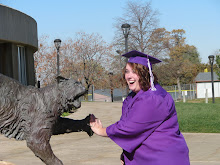Journal #31
February 14, 2012
Today’s class we were able to apply some of the teaching methods regarding vocabulary. We were assigned to come up with a vocabulary lesson either in our major or minor; then we would teach this lesson to a small group in our class.
My group consisted of Todd, Michael, and myself. We were the lucky ones who got to figure out the Smart Board and teach using it. I have to say that I did not expect to gain anything from today. I guess I felt like I heard the information from Dr. Gowans on how to teach, so why do I need to watch two guys teach. However, I was presently surprised when I walked away with new information, new ideas, and a better understanding of different teaching methods.
Within all three vocabulary lessons I learned something new (yes, even my own)!
• From my own, I learned that I need to be more aware of the words I choose. Two of my words were very similar—lugger and lubbers. Both boys had a difficult time remembering which one was which.
• From Todd’s, I learned that it is important to know exactly what you expect each student to know. He had very long definitions, but he was able to point out key words for us to recognize and match with the pictures he had.
• From Michael’s, I learned the importance of examples. He had several vocabulary words dealing with the pace of music. However, he did an awesome job of having us clap out the tempo, then speeding it up and slowing it down. With his examples I was able to connect to the word more easily.
Journal #32
February 15, 2012
“And the test of great teaching is not merely the dissection of truth. It can also be the ability and the willingness to package that truth and deliver it to the people who need it most” (James C. Howell).
As we study the state curriculum and gather our objectives, I cannot help but imagine what I want to teach and how I am going to apply all of this information to the students at Wahlquist. This quote popped into my head as I was doing my alignment assignment. Trying to come up with assessments to go with my objectives was not a difficult task—yes it took a few hours to make sure I would be reaching as many students as possible. It took time to make sure I was covering the necessary information and that it correlated with the textbook and what my cooperating teaching has asked of me.
However, while I was writing the assessments all I could think about is—what I choose needs to show me how to improve. What assessments can I do that will show me what students need more help understanding? What assessments will show me if the students are grasping the material and being able to apply it to their lives? Again, this quote by James Howell to me means that I cannot just give assessments and leave it at that (this being the truth); I must then reassess my teaching methods and teach it in a different way so the students who did not understand it the first time can grasp it in the end.
Journal #33
February 16, 2012----Personal Philosophy
My philosophy of teaching is rooted from my philosophy of learning. I believe education is one of the most vital things a person can acquire. Learning is the purpose of life and it comes from experiences you encounter. Through different experiences and situations I will create within my classroom my students will gain a better understanding of how to work with others, how to learn through different methods, and most importantly they will learn what they are capable of.
I believe each and every student has the potential to bring something unique and special to the world. I will help the students to develop their potential by believing in them as capable individuals. I will assist them in discovering who they are, so they can express their own opinions and nurture their own ideas. I have a vision of a world where people learn to respect, accept, and embrace the differences between us, as the core of what makes life so fascinating.
Every classroom presents a unique community of learners that varies not only in abilities, but also in learning styles. My role as a teacher is to give my students the tools with which to cultivate their own gardens of knowledge. To accomplish this goal, I will teach to the needs of each student so that all learners can feel capable and successful. I will present curriculum that involves the interests of my students and makes learning relevant to life. I will incorporate themes, integrated units, projects, group work, individual work, and hands-on learning in order to make my students active learners. Finally, I will tie learning into the community to help my students become caring and active members of society.
My classroom will be a caring, safe, and equitable environment where each student can blossom and grow. I will allow my students to become responsible members of our classroom community by using strategies such as class meetings, positive discipline, and democratic principles. By showing my students how to become responsible for themselves as well as their own learning, I am giving them the tools to become successful in life, to believe in themselves, and to love themselves.
Teaching is a lifelong process of learning about new philosophies and new strategies, learning from the parents and community, learning from colleagues, and especially learning from the students. In order to instill my love of learning into my students, I will continue my education and share my experiences with my students; and through my example I hope they too will discover how invaluable education truly is.
Journal #34
February 17, 2012
There are two things we discussed in class today that have already made my mind race with ideas. They are simple teaching strategies that engage the students---Active student response and I do, we do, you do.
As I have started to slowly get my lessons together, I noticed I already incorporated these two concepts without even realizing it. Within my unit on nutrition one of the state curriculum requirements is that students know how to read/ recognize items on a food label. While writing up my alignment assignment I used the “I do, we do, you do method” to instruct them on how to read a label. Also, for active student response I have included in my lessons that students will do choral response to some of my questions and my vocabulary lesson. I feel that the ASR is so easy to incorporate, because I believe to be a teacher who continues to assess every step along the way, you need the see or hear responses.
I also found the behavior methods fascinating—it opened my eyes up to new possibilities and things I did not think of encountering. One thing is clear, it is important to have classroom rules with consequences, but it is also important to follow through with them.
Reading/Writing Connection Chapter 6
12 years ago






